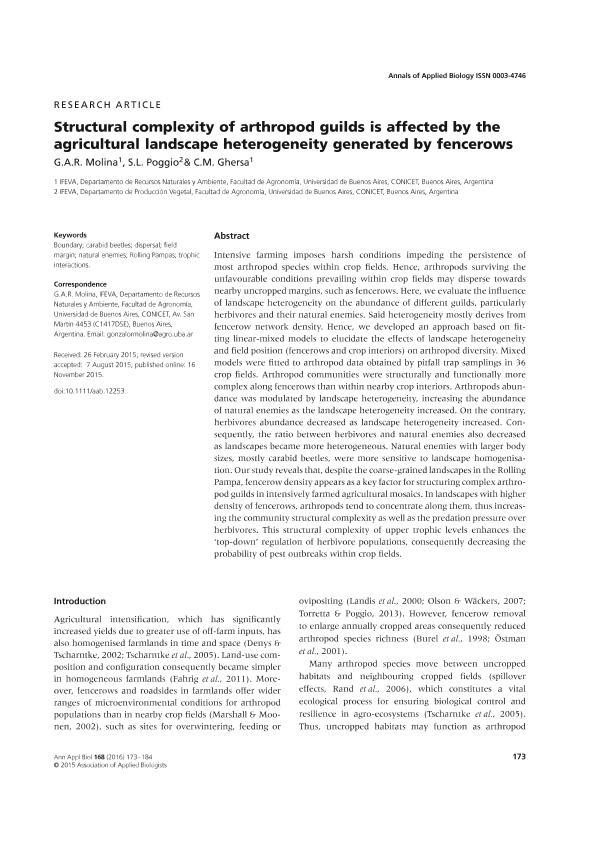Mostrar el registro sencillo del ítem
dc.contributor.author
Molina, Gonzalo Alberto Roman

dc.contributor.author
Poggio, Santiago Luis

dc.contributor.author
Ghersa, Claudio Marco

dc.date.available
2018-07-06T16:45:31Z
dc.date.issued
2016-03
dc.identifier.citation
Molina, Gonzalo Alberto Roman; Poggio, Santiago Luis; Ghersa, Claudio Marco; Structural complexity of arthropod guilds is affected by the agricultural landscape heterogeneity generated by fencerows; Wiley Blackwell Publishing, Inc; Annals of Applied Biology; 168; 2; 3-2016; 173-184
dc.identifier.issn
0003-4746
dc.identifier.uri
http://hdl.handle.net/11336/51516
dc.description.abstract
Intensive farming imposes harsh conditions impeding the persistence of most arthropod species within crop fields. Hence, arthropods surviving the unfavourable conditions prevailing within crop fields may disperse towards nearby uncropped margins, such as fencerows. Here, we evaluate the influence of landscape heterogeneity on the abundance of different guilds, particularly herbivores and their natural enemies. Said heterogeneity mostly derives from fencerow network density. Hence, we developed an approach based on fitting linear-mixed models to elucidate the effects of landscape heterogeneity and field position (fencerows and crop interiors) on arthropod diversity. Mixed models were fitted to arthropod data obtained by pitfall trap samplings in 36 crop fields. Arthropod communities were structurally and functionally more complex along fencerows than within nearby crop interiors. Arthropods abundance was modulated by landscape heterogeneity, increasing the abundance of natural enemies as the landscape heterogeneity increased. On the contrary, herbivores abundance decreased as landscape heterogeneity increased. Consequently, the ratio between herbivores and natural enemies also decreased as landscapes became more heterogeneous. Natural enemies with larger body sizes, mostly carabid beetles, were more sensitive to landscape homogenisation. Our study reveals that, despite the coarse-grained landscapes in the Rolling Pampa, fencerow density appears as a key factor for structuring complex arthropod guilds in intensively farmed agricultural mosaics. In landscapes with higher density of fencerows, arthropods tend to concentrate along them, thus increasing the community structural complexity as well as the predation pressure over herbivores. This structural complexity of upper trophic levels enhances the 'top-down' regulation of herbivore populations, consequently decreasing the probability of pest outbreaks within crop fields.
dc.format
application/pdf
dc.language.iso
eng
dc.publisher
Wiley Blackwell Publishing, Inc

dc.rights
info:eu-repo/semantics/openAccess
dc.rights.uri
https://creativecommons.org/licenses/by-nc-sa/2.5/ar/
dc.subject
Boundary
dc.subject
Carabid Beetles
dc.subject
Dispersal
dc.subject
Field Margin
dc.subject
Natural Enemies
dc.subject
Rolling Pampas
dc.subject
Trophic Interactions
dc.subject.classification
Otras Ciencias Biológicas

dc.subject.classification
Ciencias Biológicas

dc.subject.classification
CIENCIAS NATURALES Y EXACTAS

dc.title
Structural complexity of arthropod guilds is affected by the agricultural landscape heterogeneity generated by fencerows
dc.type
info:eu-repo/semantics/article
dc.type
info:ar-repo/semantics/artículo
dc.type
info:eu-repo/semantics/publishedVersion
dc.date.updated
2018-06-22T14:40:51Z
dc.journal.volume
168
dc.journal.number
2
dc.journal.pagination
173-184
dc.journal.pais
Reino Unido

dc.journal.ciudad
Londres
dc.description.fil
Fil: Molina, Gonzalo Alberto Roman. Consejo Nacional de Investigaciones Científicas y Técnicas. Oficina de Coordinación Administrativa Parque Centenario. Instituto de Investigaciones Fisiológicas y Ecológicas Vinculadas a la Agricultura. Universidad de Buenos Aires. Facultad de Agronomía. ; Argentina. Universidad de Buenos Aires. Facultad de Agronomía. Departamento de Recursos Naturales y Ambiente; Argentina
dc.description.fil
Fil: Poggio, Santiago Luis. Consejo Nacional de Investigaciones Científicas y Técnicas. Oficina de Coordinación Administrativa Parque Centenario. Instituto de Investigaciones Fisiológicas y Ecológicas Vinculadas a la Agricultura. Universidad de Buenos Aires. Facultad de Agronomía. ; Argentina. Universidad de Buenos Aires. Facultad de Agronomía. Departamento de Producción Vegetal; Argentina
dc.description.fil
Fil: Ghersa, Claudio Marco. Consejo Nacional de Investigaciones Científicas y Técnicas. Oficina de Coordinación Administrativa Parque Centenario. Instituto de Investigaciones Fisiológicas y Ecológicas Vinculadas a la Agricultura. Universidad de Buenos Aires. Facultad de Agronomía. ; Argentina. Universidad de Buenos Aires. Facultad de Agronomía. Departamento de Recursos Naturales y Ambiente; Argentina
dc.journal.title
Annals of Applied Biology

dc.relation.alternativeid
info:eu-repo/semantics/altIdentifier/doi/http://dx.doi.org/10.1111/aab.12253
dc.relation.alternativeid
info:eu-repo/semantics/altIdentifier/url/https://onlinelibrary.wiley.com/doi/abs/10.1111/aab.12253
Archivos asociados
